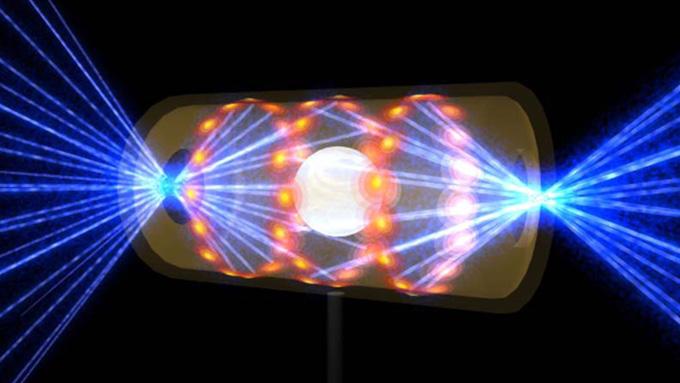In a breakthrough experiment, fusion gave off more energy than it used
The long-awaited achievement raises hopes for developing a truly clean energy source

In an experiment (illustrated), 192 powerful lasers ignited nuclear fusion in a pellet of fuel. That fusion reaction was the first one ever to release more energy than the lasers put into it.
LLNL
Scientists have finally managed to bottle the sun.
Nuclear fusion powers stars, including our sun. To do it, lightweight atoms fuse together to form heavier elements. They release energy in the process. To make them fuse, high temperatures and pressures must squeeze atoms together. Intense gravity does much of this work inside stars. But fusion is very difficult to achieve on Earth. Until now, fusing atoms in the lab has always eaten up more energy than it gave off.
A new test finally ignited a nuclear fusion reaction that unleashed more energy than it took in. This raises hopes that someday the reaction that powers the sun could also cleanly power activities here on Earth.
The experiment took place at the National Ignition Facility in Livermore, Calif. The U.S. Department of Energy announced its achievement on December 13.
“This is a monumental breakthrough,” says Gilbert Collins. This physicist works at the the University of Rochester in New York and did not take part in the new research. “Since I started in this field, fusion was always 50 years away,” Collins says. “With this achievement, the landscape has changed.”
Like three sticks of dynamite
Fusion inside stars usually squeezes together hydrogen atoms. Researchers on Earth reached the new milestone using a small pellet of fuel — deuterium and tritium. Those are heavy types of hydrogen.
Scientists trained 192 lasers on the pellet. They blasted this fuel with 2 million joules of energy. Some 4 percent of the hydrogen fused. This released about 3 million joules of energy. That’s basically the energy of two sticks of dynamite in, three sticks of dynamite out.
So, the burst emitted more energy than the lasers delivered. But it didn’t produce enough energy to run all the lab equipment powering the lasers. It took some 300 million joules of energy from the electrical grid to do the experiment. In that sense, scientists got only a hundredth of the input energy back from the fusion. So there’s still a long way to go to make fusion a practical source of energy.

Educators and Parents, Sign Up for The Cheat Sheet
Weekly updates to help you use Science News Explores in the learning environment
Thank you for signing up!
There was a problem signing you up.
“Now it’s up to the scientists and engineers to see if we can turn these physics principles into useful energy,” says Riccardo Betti. A physicist, he also works at the University of Rochester. He, too, did not take part in the new work.
Tapping into the power of fusion would be a gamechanger for clean energy. Today’s nuclear power plants are based on a process called fission. This is where heavy atoms release energy as they’re split into lighter ones. But some of those lighter atoms are radioactive. And that radioactive debris can remain dangerous for hundreds of thousands of years. Fusion, on the other hand, does not produce long-lived radioactive waste.
The new fusion breakthrough may be a turning point similar to the Wright brothers’ first flight, says Collins. “We now have a laboratory system that we can use as a compass for how to make progress very rapidly.”







